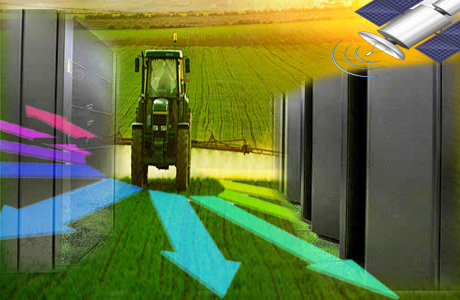Data Revolution for Agriculture
By ICT Update
 What does open data mean for agriculture? And why should people care about open data in agriculture and nutrition?
What does open data mean for agriculture? And why should people care about open data in agriculture and nutrition?
As mobile phones, tablets and improved connectivity spread across the world, the amount of data we are gathering and storing is increasing exponentially.
With every satellite launch we add further data at ever increasing detail.
Knowledge is a core input to agriculture, while data and information are the foundation of knowledge.
Is agriculture making the most of the data revolution?
In this issue of ICTupdate, we try to show it certainly is, although it seems we are yet to make progress in taking advantage of making data open for agriculture. A report by McKinsey in 2013 [1] suggests that open data could benefit the global economy by US$3 trillion a year.
To cover this revolution, we have had our own revolution here at CTA and have turned this issue of ICTupdate over to our interns for a new perspective. This issue will also be accompanied by more content online.
Open data and the data revolution.
There are various definitions of open data, including that from OpenDefinition.org: “Open data and content can be freely used, modified, and shared by anyone for any purpose,” It means data is available, accessible and can be mixed with other datasets to be made universally accessible to all. By making data truly open, we also have to give context to the data.
Tim Berners-Lee, inventor of the web and linked data initiator suggests The Five Star system [2] which provides a more comprehensive, technical definition of open data describing five different levels of openness (on the web*, machine-readable data**, non-proprietary format***, Resource Description Format standards**** and linked RDF*****).
However, very few agricultural data services achieve the five-star level of openness. A non-technical definition to the Five Star system was made by the Open Data Institute (ODI).
Dr David Tarrant (ODI) presented the approach at the GODAN workshop (20 January) as the following: available*, reusable**, open format***, use IDs for data - to link to data****, and all of the above and be able to link data to other people’s data to provide context*****.
The data revolution is a UN post-2015 initiative which refers to the transformative actions needed to respond to the demands of a complex development agenda; improvements in how data are captured and used; building capacity and data literacy in ‘small data’ and big data analytics; modernising systems of data collection; liberating data to promote transparency and accountability; and developing new targets and indicators [3].
What does open data mean for agriculture?
In terms of agriculture and open data, we are not talking about strictly agricultural data, such as yields and inputs. Rather, we are including all of the data that could be used to support food security, nutrition and agriculture. This could be satellite and meteorological data or nutritional values of crops.
Open data can potentially play a role at both macro and micro levels. At the national policy level, for example, we have seen the use of indicators to measure investment in agriculture and resultant growth in yields. Open data can help bring transparency to government spending on agriculture.
At the farmer level, access to data affects how they are managing their farms: for example, data can help farmers understand more about the threats of drought or to decide what to produce and when to take their produce to market.
Farmers can also contribute to data collection and input; What are they planting? When will it be ready for harvest? When will it be ready for the market? The data value chain in agriculture
Having access to better data and better information on yields helps set targets for agricultural production at the policy level, as well as at the farmer level.
The challenge is that data needs to be accurate, constantly updated and reliable. The ability to collect this data at different points allows for universal participation.
Why should people care about open data in agriculture and nutrition?
The agricultural sector is facing a huge demand to feed rapidly growing populations, while at the same time facing increasing threats from climate change. Agricultural production has to increase while reducing its impact on the environment – it cannot be just more fertiliser, more land being ploughed under. Equally important, we need to ensure a fairer distribution of the food produced, which calls for investments in family farming, value chains and markets that enhance food security at all levels.
Open data can facilitate this. There is an enormous amount of knowledge available from a lot of different sources: the practices of indigenous communities, new technologies developed by research institutions, tacit knowledge, knowledge transferred between generations, policy implementation, the use of products by consumers and so on. Access to these data can help us understand all aspects of food production: soil conditions, land use, the dynamics of the value chain and to identify gaps in data.
More environmental data are available where we have seen openness increase. For example, satellite imagery can give us an idea of soil moisture levels by analysing infrared reflectance. Open data present fundamental building blocks to help us understand more about the land so we can improve production and/or market access.
With open data we can intensify the use of knowledge rather than intensify agriculture.
In this issue of ICT4Ag we give a voice to various stakeholders who talk about their ideas on how to face the various challenges, and we present some practical ICT tools in the data revolution for agriculture with potential to scale out.
February 2015
Source: ICT Updates